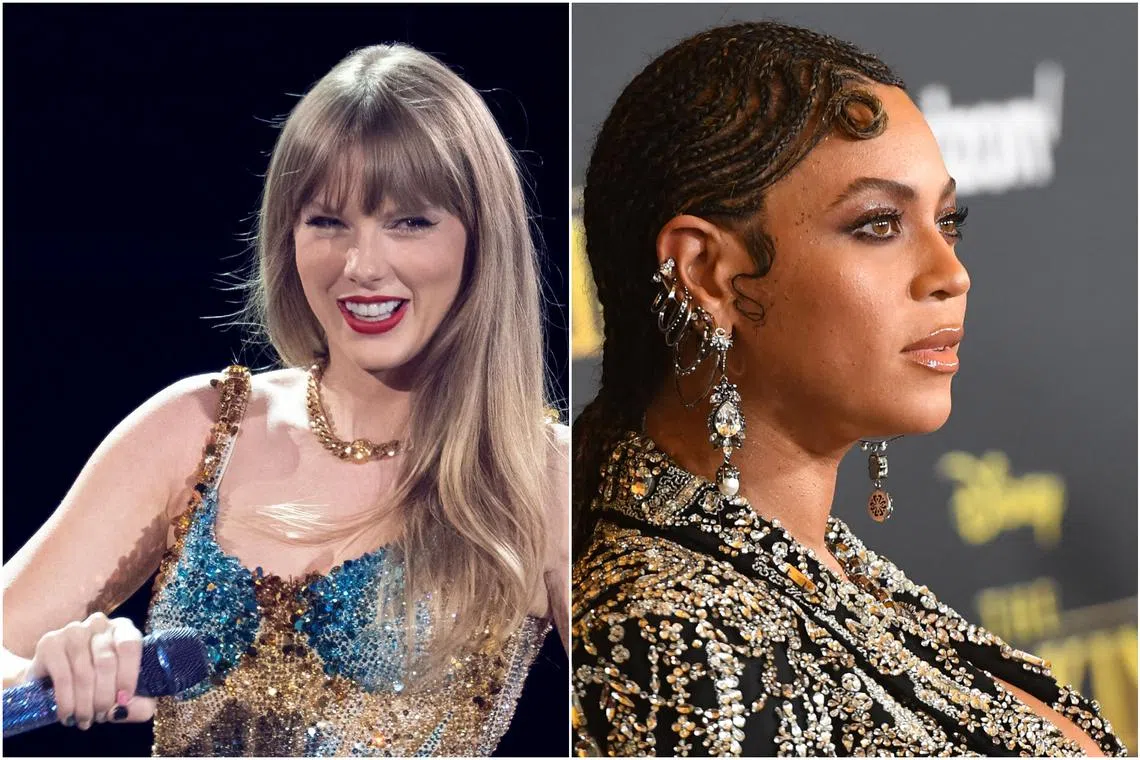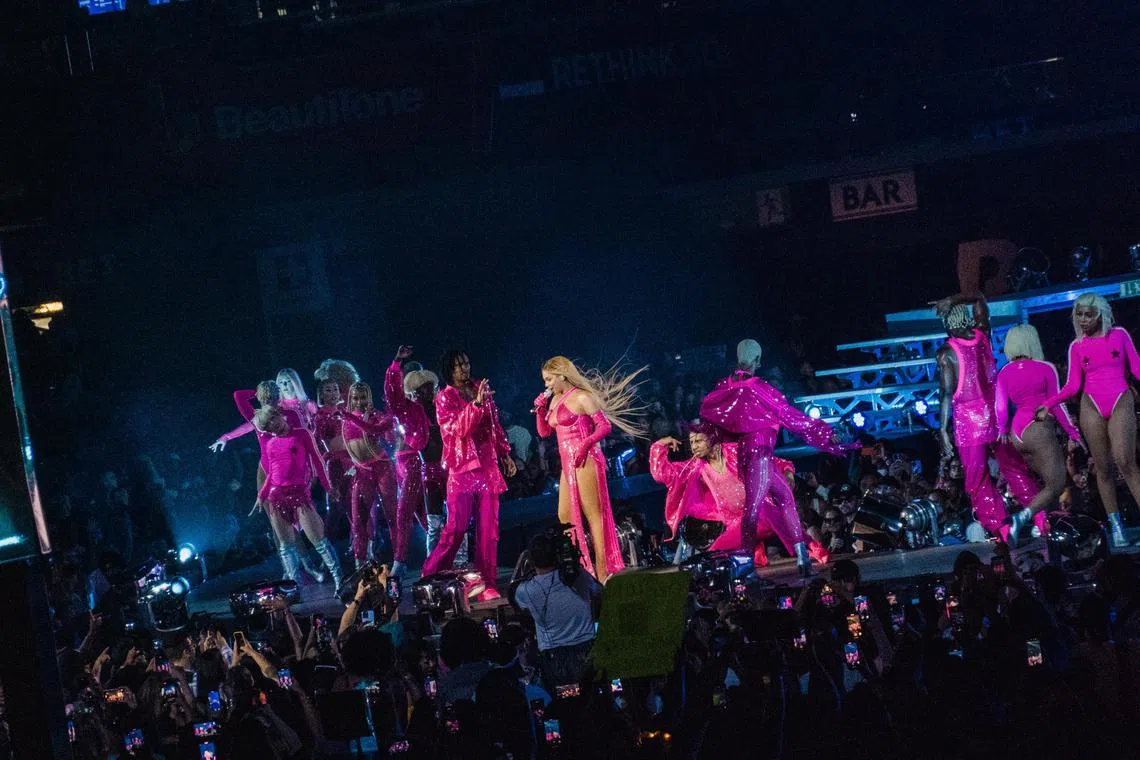Hot Tour Summer sees Taylor Swift, Beyonce eye US$1b mark
Sign up now: Get ST's newsletters delivered to your inbox

Taylor Swift (left) and Beyonce are among the dozens of stars who’ve hit the road and fuelled a booming arena market.
PHOTOS: AFP
Follow topic:
NEW YORK – It is a pop queen’s world and we are just living in it. Industry watchers are speculating over whether Tay or Bey could post the first US$1 billion (S$1.3 billion) tour, as 2023 witnesses an explosion of shows.
Taylor Swift and Beyonce are among the dozens of stars who have hit the road and fuelled a booming arena market, as demand for live entertainment soars after years of pandemic-induced cancellations and postponements.
From Pink to Coldplay, Bruce Springsteen to Drake, and SZA to The Weeknd, stadiums across the United States and beyond are setting the stage for what is poised to be the biggest year on record for live music.
“I have never seen as many artistes out at the same time, in the same space,” said Ms Stacy Merida, a professor at American University who studies the business of music.
Madonna – who in the early 1990s created the contemporary tour as we know it, with elaborate sets and costumes – was set to embark on a career-spanning tour in mid-July, but postponed it due to illness.
The 64-year-old pop star is slated to start her European leg of shows in October, and reschedule the North American concerts for later dates.
So it is the 33-year-old Swift who is now within striking distance of the billion-dollar mark, with 106 dates on her The Eras Tour.
Odds are also favouring Beyonce as she commences the North American leg of her Renaissance World Tour.
If either cross the history-making line, they will jump past pop superstar Elton John.
His Farewell Yellow Brick Road tour, which began in 2018 and just ended, had grossed more than US$910 million as of June 18, a few weeks before his final show in Stockholm on July 8, according to Billboard Boxscore.
John had surpassed the previous record-holder, English singer-songwriter Ed Sheeran’s 2017-2019 Divide tour, which nabbed US$776 million.
Part of the current boom comes from increased ticket prices. Sheeran charged just under US$100 for Divide, according to tracker Pollstar, but played more than 200 shows.
Tickets for Beyonce and Swift are averaging out to be more than double that for basic seats.

Taylor Swift performing on the first night of her Eras Tour at AT&T Stadium in Arlington, Texas, in March.
PHOTO: AFP
Live Nation, which in 2010 merged with Ticketmaster, says it has already sold 100 million tickets for 2023 concerts – more than it sold for the entire year of 2019.
The company posted US$4.4 billion in revenue during 2023’s second quarter, promoting some 12,500 concerts to 33.5 million fans.
“With most of the world fully reopened, it is clear that concerts remain a high priority for fans,” said Live Nation in its most recent earnings report.
But while demand has soared, it is not without much grumbling over the privileged position of Live Nation and Ticketmaster.
For years, concertgoers have complained of hidden fees, soaring costs, rampant scalpers and limited tickets due to presales.
The issue reignited earlier in 2023 after botched sales for Swift’s tour wreaked havoc, prompting a congressional hearing over purported anti-competitive practices and ardent calls for the company to be broken up.
That possibility does not appear to be on the horizon, and ticket prices keep climbing in the meantime – and fans keep paying.
“The vertical integrated monopoly really has a lot of ripple effects in terms of prices,” said Mr Andrew Leff, a music industry veteran and attorney who teaches at the University of Southern California.
“If you’re Ticketmaster and you can charge anything you want and don’t have any competition, and a demand for Taylor Swift or Beyonce comes along, that’s simple supply-and-demand economics,” he said.
“It can charge whatever it wants, which is what it does.”

Beyonce (centre) at her opening show for the North American leg of her tour, at the Rogers Center in Toronto on July 8.
PHOTO: NYTIMES
And, Mr Leff added, the concert boom is not necessarily seeing its benefits trickle down to smaller acts.
“There’s really two music industries,” he said. “There’s the music industry for the one per cent and the music industry for the 99 per cent.”
“Unless you’re playing in front of 500 people or more every night, you’re probably not breaking even.”
It is an all too familiar story. Touring does not come cheap, and it is a lifeline for artists whose royalties from streaming notoriously make the tiniest of dents.
But with everyone back on the road trying to make up lost revenue from the Covid-19 pandemic years, there is competition for everything from venues to tour buses.
Last fall, indie artist Santigold was among the first to speak out on the challenges facing performers like her – and cancelled her tour, saying she was “simply unable to make it work”, not least due to inflation and competition in a saturated market.
Meanwhile, recent data from research company QuestionPro suggests Swift’s tour could generate some US$4.6 billion in consumer spending in the US alone, pumping dollars into local economies, including hotels and restaurants.
And Queen Bey’s Renaissance tour caused a “Beyonce blip” when she performed in Stockholm in May, driving up Sweden’s inflation about 0.2 percentage points.
“Beyonce’s start of her world tour in Sweden seems to have coloured May inflation,” said Mr Michael Grahn, chief economist for Sweden at Danske Bank at the time. AFP

